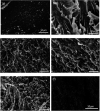Cyanate ester resin based composites with high toughness and thermal conductivity
- PMID: 35515935
- PMCID: PMC9060895
- DOI: 10.1039/c8ra10244a
Cyanate ester resin based composites with high toughness and thermal conductivity
Abstract
A new cyanate ester resin-based composite with higher toughness and thermal conductivity was developed. First, a poly(n-butyl acrylate)/poly(methyl methacrylate-co-acrylamide) (PBMAM) core-shell structured latex was prepared by seeded emulsion polymerization. Second, hexagonal boron nitride (h-BN) particles were modified by a surface coupling agent, 3-(2-amino ethyl amino)propyl trioxysilane, to improve the dispersion in cyanate ester resin (BADCy). Third, PBMAM and the modified boron nitride were mixed with BADCy resin to increase mechanical properties and thermal conductivity. The monomer conversion in the emulsion polymerization process of the PBMAM was monitored by determining the solid content. Its particle size was characterized by dynamic laser scattering, and the morphology of the particles was characterized using scanning and transmission electron microscopes. The modified boron nitride (ABN) was verified by FTIR and TGA measurements. The mechanical properties and thermal conductivity of the BADCy/PBMAM/ABN composites were determined at various BN contents. Results showed that the unnotched impact strength of the composite increased by 151% and the thermal conductivity increased by 85% at a PBMAM content of 5 wt% and ABN content of 6 wt%. With the enhanced properties and ease of fabrication, the developed composites have good potential for application in high-end industries such as microelectronic packaging.
This journal is © The Royal Society of Chemistry.
Conflict of interest statement
There are no conflicts to declare.
Figures











Similar articles
-
Enhanced toughness and thermal conductivity for epoxy resin with a core-shell structured polyacrylic modifier and modified boron nitride.RSC Adv. 2019 Mar 15;9(15):8654-8663. doi: 10.1039/c8ra10645b. eCollection 2019 Mar 12. RSC Adv. 2019. PMID: 35518695 Free PMC article.
-
Study on the Relationships between Microscopic Cross-Linked Network Structure and Properties of Cyanate Ester Self-Reinforced Composites.Polymers (Basel). 2019 Jun 1;11(6):950. doi: 10.3390/polym11060950. Polymers (Basel). 2019. PMID: 31159387 Free PMC article.
-
Synergistic Effects of Functional CNTs and h-BN on Enhanced Thermal Conductivity of Epoxy/Cyanate Matrix Composites.Nanomaterials (Basel). 2018 Dec 3;8(12):997. doi: 10.3390/nano8120997. Nanomaterials (Basel). 2018. PMID: 30513909 Free PMC article.
-
Multifunctional cyanate ester nanocomposites reinforced by hexagonal boron nitride after noncovalent biomimetic functionalization.ACS Appl Mater Interfaces. 2015 Mar 18;7(10):5915-26. doi: 10.1021/acsami.5b00147. Epub 2015 Mar 5. ACS Appl Mater Interfaces. 2015. PMID: 25726956
-
Thermal Conductivity of Epoxy Resin Composites Filled with Combustion Synthesized h-BN Particles.Molecules. 2016 May 20;21(5):670. doi: 10.3390/molecules21050670. Molecules. 2016. PMID: 27213325 Free PMC article.
Cited by
-
Processing and Characterization of Aerospace Composites for Advanced Radome Applications.ACS Omega. 2025 Aug 5;10(32):36421-36431. doi: 10.1021/acsomega.5c04792. eCollection 2025 Aug 19. ACS Omega. 2025. PMID: 40852280 Free PMC article.
-
Biodegradation of hydroxylated boron nitride nanoplatelets, their toxic effect and drug delivery application.RSC Adv. 2024 Aug 22;14(36):26568-26579. doi: 10.1039/d4ra04433a. eCollection 2024 Aug 16. RSC Adv. 2024. PMID: 39175687 Free PMC article.
-
Breaking graphite through a ball-milling process: the thermal conductivity and mechanical properties of polyethylene composites.RSC Adv. 2024 Sep 2;14(38):27948-27956. doi: 10.1039/d4ra03653k. eCollection 2024 Aug 29. RSC Adv. 2024. PMID: 39224632 Free PMC article.
-
Silver-Loaded Carbon and Phosphorous Co-Doped Boron Nitride Quantum Dots (Ag@CP-BNQDs) for Efficient Organic Waste Removal: Theoretical and Experimental Investigations.ACS Omega. 2022 Oct 17;7(42):37620-37628. doi: 10.1021/acsomega.2c04480. eCollection 2022 Oct 25. ACS Omega. 2022. PMID: 36312368 Free PMC article.
-
Di-Cyclohexene Oxide Bridged by DDSQ: Preparation, Characterization, and Application as Fillers for Cyanate Ester Resin.Molecules. 2025 Feb 28;30(5):1113. doi: 10.3390/molecules30051113. Molecules. 2025. PMID: 40076336 Free PMC article.
References
-
- Wang Z. Zhou W. Dong L. Sui X. Cai H. Zuo J. Chen Q. J. Alloys Compd. 2016;682:738–745. doi: 10.1016/j.jallcom.2016.05.025. - DOI
-
- Gu J. Yang X. Li C. Kou K. Ind. Eng. Chem. Res. 2016;55:10941–10946. doi: 10.1021/acs.iecr.6b03093. - DOI
-
- Zhu Y. Ye X. Rong M. Zhang M. Compos. Sci. Technol. 2016;135:146–152. doi: 10.1016/j.compscitech.2016.09.020. - DOI
-
- Fang F. Huang G. Xiao H. Li Y. Hu N. Fu S. Compos. Sci. Technol. 2018;156:144–150. doi: 10.1016/j.compscitech.2018.01.001. - DOI
LinkOut - more resources
Full Text Sources

